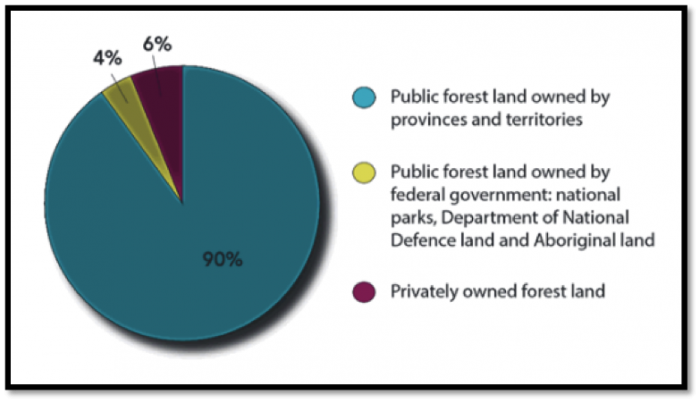Have you ever wondered who owns Canada’s vast forest network and how it is managed? Look no further for your answers as we investigate the Canadian forest tenure system.

Did you know that Canada is 40% covered in forests and at the same time, home to over thirty-six million people? Understanding who owns and can use forested areas in this country can be somewhat tricky. To understand forests in Canada and Alberta we need to know that in general forests can be:
- Accessed
- Managed
- Owned
- Used
Canadian forests cover 402 million hectares of land. (Need help visualizing a hectare? In this article, sports fields are used to compare forest sizes in Alberta and BC). Of those 402 million hectares of forest, 94 percent is publicly owned, meaning that the right to own forests is primarily held by government. Since forests are publicly owned, use of the forest is determined by what’s called a forest tenure agreement.

Figure 1. Visualizing Canada’s forests.
Retrieved from: Natural Resources Canada (2018), http://www.nrcan.gc.ca/forests/report/area/17601
Having the vast majority of our forests publicly owned sets us apart from our neighbours to the south. In the United States over half of the forests are privately owned. Globally, Canada is also a standout with an extremely high proportion of publicly owned forests compared to other developed nations that also have lots of trees. Why is Canada so different? Well, in the early 1800s The Crown developed forest licensing agreements which allowed companies to harvest trees in exchange for paying a fee to the government. Over time, control of forests was passed to the provinces and territories and use of the same tenure system continued.

Figure 2. Division of forest land ownership in Canada. Retrieved from: Natural Resources Canada (2017), http://www.nrcan.gc.ca/forests/canada/ownership/17495
Tenure in Canada has evolved and today’s system is more robust, considering the complexities of the resource. A pivotal characteristic of forest management in Canada is sustainable management. What is sustainable management? Well when practicing sustainable management, planners consider a balance of ecological, economic, and social values so that the renewable resource is available now and for future generations. Provinces and territories must fulfill lots of responsibilities to make sure that sustainable management is occurring. For example, the government ensures that fish and wildlife are protected, impacts on water resources are minimized, and seedlings are planted for forest regeneration. Part of the government’s role in sustainable management is the granting of access rights to companies through three types of tenure:
- Forest Management Agreements
- Timber Quotas
- Timber Permits
Want to know more about the specifics of tenure types in Alberta? The Ministry of Agriculture and Forestry has a very detailed page, describing tenure types and characteristics, take a look!
With the overarching principle of sustainability sewn into the fabric of forest management in Alberta and broadly across Canada, the characteristics of sustainable forest management guide all forestry activities. Forestry in Canada is a dynamic arrangement that is subject to economic, social, and ecological fluctuations. A relevant tenure system is responsive and adaptive in order to effectively contribute to sustainable forest management in the diverse Canadian forestry landscape.
Interested in understanding sustainable forest management a bit better? Take a couple minutes to watch this TED Talk where Kathy Abusow of the Sustainable Forestry Initiative talks all things sustainable in forestry.
Sources
Butler, J.B., Hewes, J.H., Dickinson, B.J., Andrejczyk, K., Butler, S.M., & Markowski-Lindsay, M. (2016). USDA Forest Service National Woodland Owner Survey: National, Regional, and State Statistics for Family Forest and Woodland Ownership with 10+ acres, 2011-2013. A technical document supporting the Forest Service Update of the 2010 RPA Assessment. Resource Bulletin NRS-99.
Luckert, M.K., Haley, D., & Hoberg, G. (2011). Policies for sustainably managing Canada’s forests. Vancouver, BC: UBC Press.